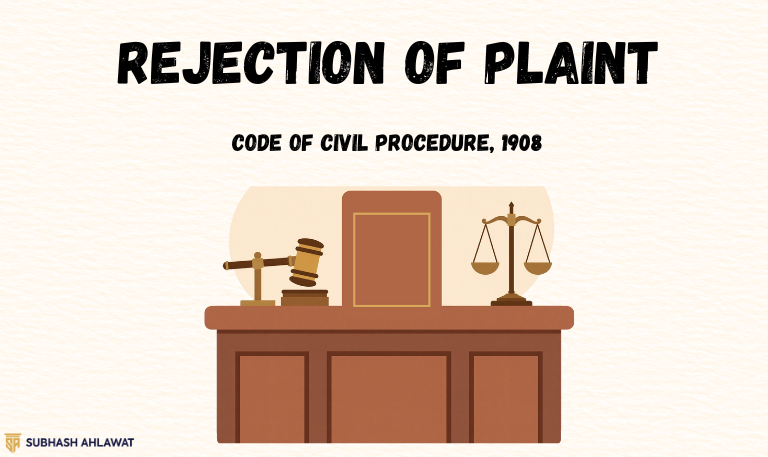Application Under Order VII Rule 11 of the Code of Civil Procedure

Order VII Rule 11 of the Code of Civil Procedure, 1908 (CPC), embodies one of the most significant procedural safeguards within civil litigation. It empowers the court to reject a plaint at the very threshold if certain statutory conditions are satisfied. The purpose of this provision is to prevent misuse of the judicial process and to ensure that the courts are not burdened with frivolous, vexatious, or legally untenable suits. The provision also reinforces the larger objective of judicial economy, efficiency, and avoidance of unnecessary trials. An application under Order VII Rule 11 can be made at any stage of the suit, including before registration of the plaint, after issuance of summons, or even during later proceedings, provided the grounds for rejection fall strictly within the parameters laid down under the Rule.
Statutory Grounds for Rejection of Plaint
Order VII Rule 11 specifies the exact circumstances in which a plaint is liable to be rejected. The provision is strict and exhaustive, meaning that rejection must stem only from the grounds enumerated therein. The primary grounds include:
(a) where the plaint does not disclose a cause of action;
(b) where the relief claimed is undervalued, and the plaintiff fails to correct the valuation despite direction;
(c) where the plaint is insufficiently stamped or inadequately paid, and the plaintiff does not make good the deficiency;
(d) where the suit appears from the statements in the plaint to be barred by law;
(e) where the plaint is not filed in duplicate; and
(f) where statutory requirements for filing — such as compliance with provisions relating to suits involving public matters — are not met.
Each ground operates independently. For instance, even if a plaint discloses a cause of action, it may still be rejected if the court concludes, solely on the basis of the plaint, that the suit is barred by law. The cornerstone of this provision is that the court must confine its assessment exclusively to the plaint and the documents accompanying it. The court is not permitted to consider the defence of the defendant, written statements, or external materials while ruling on such an application. This ensures that the rejection proceeds strictly on legal parameters and not on disputed factual considerations.
Scope and Nature of Judicial Examination
The discretion under Order VII Rule 11 is not arbitrary but is guided by well-settled principles of civil jurisprudence. The court is required to undertake a meaningful and not merely formal reading of the plaint. The intention is to ascertain the true nature of the cause of action, the actual substance of the claim, and the legal sustainability of the relief sought. If, on a careful reading, the plaint reveals that the claim is illusory, vexatious, or inherently incapable of being entertained, the court is duty-bound to reject it.
The assessment of whether a plaint discloses a cause of action involves determining whether it sets out all material facts which, if proved, would entitle the plaintiff to a decree. A cause of action must be real and actionable, not hypothetical or vague. Similarly, when determining whether a suit is barred by law, the court must restrict itself to the statements in the plaint. If from those statements the suit is evidently barred by statutory provisions, the court need not and cannot go beyond the plaint.
The scope of judicial scrutiny is intentionally narrow to prevent premature examination of contested issues. The rule is not meant to decide the merits of the case at this stage but only to ensure that the essential legal prerequisites for maintaining the suit are satisfied. Consequently, Order VII Rule 11 acts as a preliminary checkpoint and not a substitute for trial.
Procedural Aspects and Effect of Rejection
An application under Order VII Rule 11 may be filed by the defendant, or the court may exercise the power suo motu if it notices any deficiency in the plaint. There is no limitation period for filing such an application, and it may be made at any point during the proceedings. The court is required to dispose of such applications expeditiously, given that they challenge the maintainability of the suit itself.
The rejection of a plaint under this rule is a deemed decree under the CPC. As a result, the plaintiff is entitled to challenge the rejection by way of an appeal. This classification underscores the seriousness of the consequences that flow from such orders. Rejection of the plaint does not, however, amount to dismissal of the suit on merits. It merely indicates that the plaint, in its present form, is not maintainable. Importantly, if the rejection is based on technical grounds such as improper valuation or insufficient court fee, the plaintiff may cure the defect and file a fresh plaint. However, if the rejection stems from legal bars or absence of cause of action, a fresh suit may be impermissible or futile.
The process also upholds the principle that a litigant cannot secure judicial intervention by circumventing mandatory procedural requirements. Thus, the provision strengthens procedural discipline within civil litigation.
Significance, Limitations, and Judicial Approach
Order VII Rule 11 serves as a critical filter that safeguards courts from being inundated with meritless suits. It promotes discipline in pleadings and ensures that plaintiffs carefully draft plaints with complete and accurate material facts. It simultaneously protects defendants from undergoing unwarranted trial expenses and delays where the plaint is fundamentally defective.
However, the provision has inherent limitations designed to protect the plaintiff’s right to access the courts. Courts must exercise caution to avoid rejecting plaints based on incomplete appreciation of issues that properly belong to the trial stage. The power must not be used to shut out genuine claims merely because the defendant disputes the facts or raises complex issues. The boundary between absence of cause of action and weak cause of action must be respected; only the former warrants rejection.
The judicial approach requires a balanced and meticulous examination. Courts endeavour to ensure that procedural safeguards do not transform into procedural impediments. The provision is applied sparingly, with the understanding that the rejection of a plaint is an exceptional measure. The overall objective is to uphold the integrity of civil procedure while ensuring that justice remains accessible.
Conclusion
Order VII Rule 11 of the CPC is a vital procedural tool designed to prevent abuse of judicial resources and to ensure that civil courts entertain only those suits that disclose a legitimate cause of action and comply with legal requirements. While the power conferred is wide, it is exercised with caution and confined strictly to the grounds enumerated under the Rule. Its purpose is not to adjudicate disputed facts but to filter out suits that are defective, barred by law, or devoid of actionable claims. Through its application, the civil justice system benefits from improved efficiency, reduced frivolous litigation, and enhanced procedural fairness.


